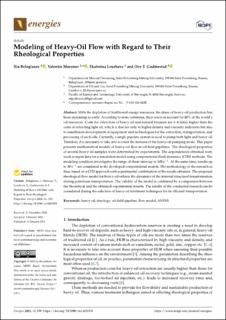| dc.contributor.author | Beloglazov, Ilia | |
| dc.contributor.author | Morenov, Valentin | |
| dc.contributor.author | Leusheva, Ekaterina | |
| dc.contributor.author | Gudmestad, Ove Tobias | |
| dc.date.accessioned | 2023-02-16T13:14:02Z | |
| dc.date.available | 2023-02-16T13:14:02Z | |
| dc.date.created | 2021-01-11T14:59:49Z | |
| dc.date.issued | 2021 | |
| dc.identifier.citation | Beloglazov, I., Morenov, V., Leusheva, E., & Gudmestad, O. T. (2021). Modeling of heavy-oil flow with regard to their rheological properties. Energies, 14(2), 359. | en_US |
| dc.identifier.issn | 1996-1073 | |
| dc.identifier.uri | https://hdl.handle.net/11250/3051546 | |
| dc.description.abstract | With the depletion of traditional energy resources, the share of heavy-oil production has been increasing recently. According to some estimates, their reserves account for 80% of the world’s oil resources. Costs for extraction of heavy oil and natural bitumen are 3–4 times higher than the costs of extracting light oil, which is due not only to higher density and viscosity indicators but also to insufficient development of equipment and technologies for the extraction, transportation, and processing of such oils. Currently, a single pipeline system is used to pump both light and heavy oil. Therefore, it is necessary to take into account the features of the heavy-oil pumping mode. This paper presents mathematical models of heavy-oil flow in oil-field pipelines. The rheological properties of several heavy-oil samples were determined by experiments. The dependencies obtained were used as input data for a simulation model using computational fluid dynamics (CFD) methods. The modeling condition investigates the range of shear rates up to 300 s−1. At the same time, results up to 30 s−1 are considered in the developed computational models. The methodology of the research is, thus, based on a CFD approach with experimental confirmation of the results obtained. The proposed rheological flow model for heavy oil reflects the dynamics of the internal structural transformation during petroleum transportation. The validity of the model is confirmed by a comparison between the theoretical and the obtained experimental results. The results of the conducted research can be considered during the selection of heavy-oil treatment techniques for its efficient transportation. | en_US |
| dc.language.iso | eng | en_US |
| dc.publisher | MDPI | en_US |
| dc.rights | Navngivelse 4.0 Internasjonal | * |
| dc.rights.uri | http://creativecommons.org/licenses/by/4.0/deed.no | * |
| dc.title | Modeling of Heavy-Oil Flow with Regard to Their Rheological Properties | en_US |
| dc.title.alternative | Modeling of Heavy-Oil Flow with Regard to Their Rheological Properties | en_US |
| dc.type | Peer reviewed | en_US |
| dc.type | Journal article | en_US |
| dc.description.version | publishedVersion | en_US |
| dc.rights.holder | The authors | en_US |
| dc.subject.nsi | VDP::Teknologi: 500 | en_US |
| dc.source.pagenumber | 15 | en_US |
| dc.source.volume | 14 | en_US |
| dc.source.journal | Energies | en_US |
| dc.source.issue | 2 | en_US |
| dc.identifier.doi | 10.3390/en14020359 | |
| dc.identifier.cristin | 1869153 | |
| cristin.ispublished | true | |
| cristin.fulltext | original | |
| cristin.fulltext | original | |
| cristin.qualitycode | 1 | |

